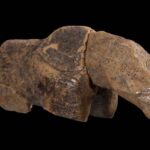Archaeologists conducting excavations at the Hohle Fels cave in southwestern Germany made a surprising discovery that challenged previous assumptions about an ancient ivory artifact. Initially thought to be a representation of a horse’s head, further excavations revealed that the ivory figurine was not a horse at all.

Unidentified Animal Representation
Led by University of Tübingen professor Nicholas Conard, the team of archaeologists uncovered additional pieces of the ivory figurine during recent excavations at Hohle Fels. Contrary to previous beliefs, the newly recovered pieces did not align with the characteristics of a horse. Instead, the animal depicted remains unidentified, with suggestions ranging from a cave lion to a cave bear.
Ancient Origins
The excavation layer where the ivory figurine was found dates back to the Aurignacian Paleolithic culture, approximately 35,000 years ago. Situated within the Swabian Jura Biosphere Reserve, Hohle Fels has been a significant site for archaeological exploration, yielding artifacts from various ancient cultures over several decades.

Reevaluation of the Figurine
Initial interpretations of the ivory figurine were based on the elongated shape of its head, leading to the assumption that it depicted a horse. However, the discovery of additional pieces, particularly a curved shell-like artifact identified as part of the animal’s shoulder and thorax, prompted a reevaluation of its identity.
Archaeological Detective Work
Through meticulous examination of ivory fragments, archaeologists pieced together the puzzle of the figurine’s true identity. The recovered pieces revealed a body shape inconsistent with that of a horse, suggesting characteristics more akin to a bear. However, conclusive identification remains elusive due to the fragmentary nature of the artifact.

Ongoing Research and Museum Display
Despite the discovery of five connectible statue pieces, the ivory figurine remains incomplete. It will be returned to the Prehistoric Museum in Blaubeuren for public display, accompanied by the acknowledgment of its uncertain identity. Archaeologists continue their work at Hohle Fels, hoping to uncover more pieces of the puzzle and shed further light on the ancient past.
Conclusion: The Everlasting Pursuit of Knowledge
The case of the Hohle Fels “horse” exemplifies the dynamic nature of archaeological research. As new evidence emerges and interpretations evolve, our understanding of ancient artifacts and cultures deepens. Through ongoing exploration and meticulous analysis, archaeologists strive to unlock the mysteries of the past, ensuring that nothing is lost over the passage of time.





